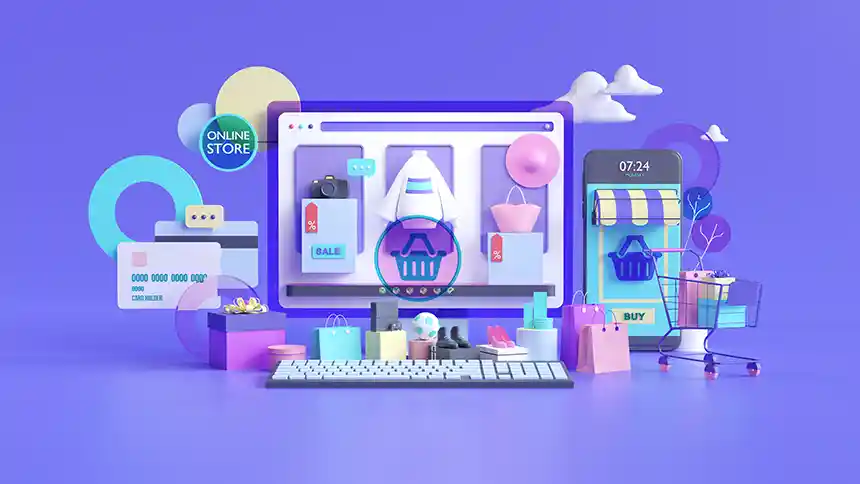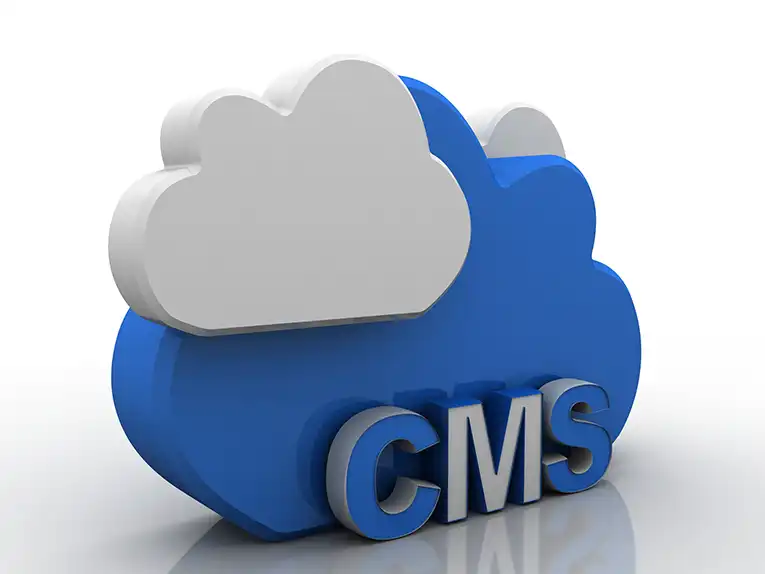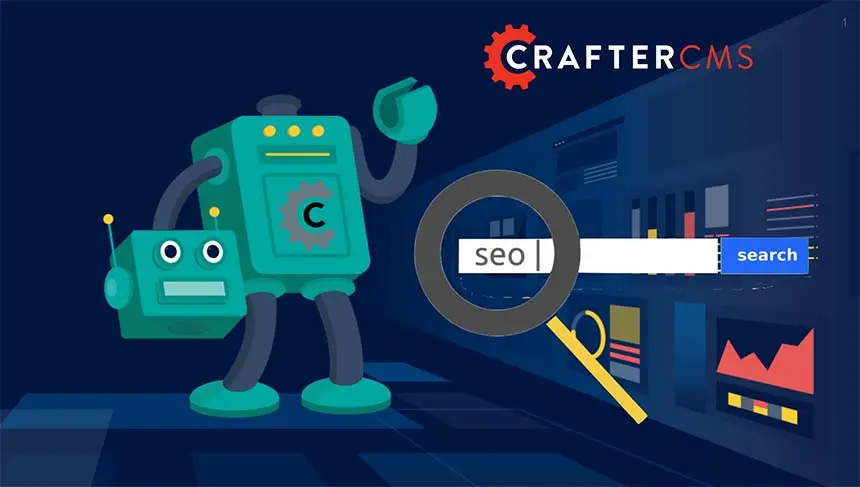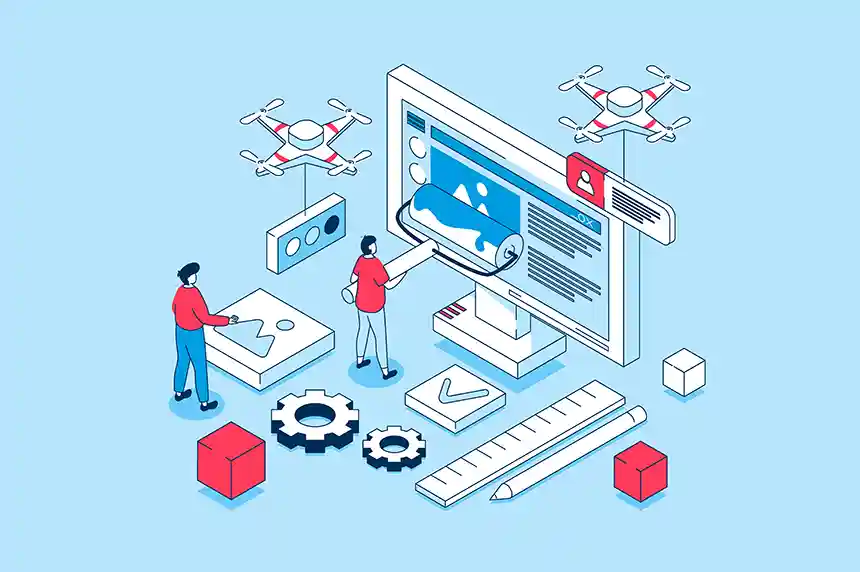Headless Commerce: A Comprehensive Guide to Building Immersive Shopping Experiences

Amanda Jones

Shopping online once meant logging onto your home computer, browsing a few stores (or Amazon) to compare prices, and then purchasing. Times have changed, and consumers have moved from shopping on their desktops to purchasing from mobile devices. Another trend is buying online and picking up in-store. They are also now embracing social commerce and buying their favorite products directly on social media platforms.
These omnichannel requirements have pushed brands to modernize their digital shopping experiences. Once constituting 18% of global retail sales in 2017, eCommerce is forecasted to constitute 41% of total sales by 2027. If the number of channels wasn’t enough, consumers also expect eCommerce websites to be fast and high-performing to make their experience enjoyable.
So, how can brands meet ever-changing customer expectations, cater to them on multiple channels, and build an immersive shopping experience?
The answer is headless commerce.
This article will explain headless commerce and how it differs from traditional commerce approaches, the benefits of adopting headless eCommerce, and showcase the role a headless CMS plays in making immersive shopping experiences a reality.
What Is Headless Commerce?
Headless commerce is an eCommerce model where the frontend presentation layer of the eCommerce store is separated from the backend eCommerce functionality. Like a headless CMS or other headless architecture, the ‘head’ of the eCommerce store is removed. These two layers are connected using APIs so that data from the backend can be shared with the frontend and vice versa.
By decoupling the frontend layer from the eCommerce functionality, headless commerce provides more flexibility for brands wanting to make the most of today’s digital shopping channels. It enables them to create eCommerce storefronts on any channel or device, from a smartphone or social media app to a digital kiosk in the mall or other IoT-connected devices.
How Does Headless Commerce Work?
Headless commerce involves removing the front end or head of an eCommerce system from the backend commerce logic. The head can then be replaced with different customer-facing front ends or eCommerce storefronts.
The frontend refers to anything visitors see when visiting an eCommerce site: the design, layouts, and other interactive elements. With headless commerce, developers can build new interactive interfaces for any device or app, allowing them to display a shopping experience on a website or mobile app, a wearable device, a chatbot, or a digital sign. Ecommerce brands often integrate a headless CMS to help create those diverse frontend experiences.
Meanwhile, the backend commerce functionality is handled by the eCommerce platform. This includes inventory management, order fulfillment, checkout, payment processing, and other details.
Just like with a traditional commerce approach, all that happens in the backend is hidden from the customer. If they go to a store to purchase a new watch from a mobile device, the frontend makes an API request to the commerce platform to supply the product information and display it to the potential customer.
Once the customer is ready to purchase, another request is sent to process their order amount, credit card information, and other details. Meanwhile on the frontend, the customer sees that their order has been successfully completed and delivery details will be in their inbox.
Headless Commerce vs Composable Commerce
When companies enter the world of headless commerce, they will also come across the term composable commerce. While these two terms are related, there is also a notable difference.
Whereas headless commerce focuses on giving flexibility to the frontend and enabling companies to create shopping experiences on multiple channels, composable commerce is like the next stage of headless commerce. It extends that flexibility to the backend by breaking down the entire commerce stack into modular, interchangeable components.
Composable commerce emphasizes assembling best-of-breed, specialized services that can be easily integrated to create a tailored commerce solution. Instead of just an eCommerce platform and a headless CMS as might be involved in headless commerce, a composable commerce stack may include an eCommerce platform, headless CMS, shipping platform, payment gateway, and several other modular solutions.
Further Reading: Composable Commerce: Composing Content-Rich Experiences with a Headless CMS
Headless Commerce vs Traditional Commerce
Headless commerce is a modern approach to eCommerce that differs from the traditional, monolithic approach to eCommerce. In the past, traditional eCommerce platforms (Magento, Hybris, Demandware, ATG, etc.) provided everything brands needed to launch an online retail site. This meant templates and themes that streamlined the authoring of websites with integrated features for product catalogs, shopping carts, and payment processing.
The problem is that these platforms lacked flexibility and weren’t good for managing different shopping experiences. Frontend changes often required substantial database and code edits by developers that drastically slowed marketing agility. These days, however, the ability to quickly adopt new channels and deliver content-driven personalized shopping experiences is critical for driving eCommerce success. Here are some ways the traditional and headless approaches differ:
Architecture
While headless commerce separates the front and backend, in a traditional commerce approach, these two layers are tightly coupled. While this might seem easier, it also meant more limitations on the types of shopping experiences that could be created and placed limits on flexibility.
Flexibility
Traditional commerce solutions often lack the flexibility and customizability required for a modern business. This means traditional commerce could be sufficient for simple, straightforward use cases such as an eCommerce shop with only a few items.
However, if businesses want to create new eCommerce shops on different channels, adjust the layout of the existing store, add new features, or integrate with other tools, it can be time-consuming to customize.
Frontend Experiences
Traditional eCommerce platforms — much like traditional CMSs — pose limitations on the frontend possibilities. Typically, these platforms had templates, themes, and other tools for building responsive retail websites but no capabilities for emerging digital touchpoints or modern frontend technologies.
However, companies can build frontend shopping experiences on nearly any API-enabled device with the headless approach. That means developers can choose the tools and frontend frameworks that work best, whether it’s React, Next.js, Freemarker, a native mobile framework, or a technology that’s yet to be seen. They’re future-proofed for any channels their customers demand later on.
Channels and Shopping Experiences
With a lack of omnichannel marketing features, traditional eCommerce platforms have struggled to deliver seamless shopping experiences in the modern era. That’s because content creation and delivery are closely coupled with the frontend — usually a traditional website. Content created using these systems, which fits into templates and other pre-built components, has limited reuse.
On the other hand, headless commerce allows marketing teams to easily reuse content and product information across many channels. This dramatically improves brand consistency and leads to a better experience-led commerce strategy. By leveraging APIs, companies can also let customers start browsing products from one touchpoint and easily switch to another when they’re ready to make a purchase. Headless commerce allows different channels to be tightly integrated into a unified shopping experience.
Speed and Performance
Most traditional eCommerce platforms generally have a slow time to market because marketers must adapt their new and existing content to fit the templates and components of that particular system. Developers often need to learn proprietary technical knowledge related to the platform before they can build frontend shopping experiences.
With a headless commerce approach, companies can quickly launch many sites for different brands, market segments, or regions. That’s because developers can work in parallel with content authors to reduce the time to market significantly. Content is also not coupled to a particular frontend, so there’s much less duplicate work that the marketing department has to do.
Drawbacks of Monolithic Commerce
Aside from the differences between headless and traditional commerce approaches, there are additional drawbacks for businesses that choose to remain with a monolithic commerce solution.
- Lack of Innovation: It’s harder for businesses to innovate with traditional commerce systems. The rigid structures make it difficult to adopt new technologies or features and embrace new channels.
- Security and Maintenance: Security vulnerabilities in one part of a monolithic system can potentially affect the entire platform. Plus, they frequently require maintenance and patches to deal with ongoing issues.
- Total Cost of Ownership: Companies relying on monolithic commerce systems will typically incur a higher total cost of ownership as security and maintenance costs, plus the reliance on specialized developers will increase what businesses need to spend.
Benefits of Headless Commerce
Brands that adopt headless commerce can realize many benefits for their eCommerce shops and overall businesses.
Omnichannel Shopping Experiences
Headless commerce opens the door to omnichannel marketing for brands. Consumers can now receive content on a website, a mobile app, via a smart speaker, or just about any IoT-connected device. This explosion of channels has created a real need for marketing on multiple channels simultaneously.
With omnichannel marketing, brands can create content for these multiple channels and ensure the brand experience remains the same throughout each touchpoint. With the flexibility that omnichannel marketing offers, brands can finally hone in on creating the shopping experiences that their customers want.
Personalization
Consumers today want brands to treat them as individuals and not simply offer the same blanket marketing campaigns to everyone interacting with them. Headless commerce allows brands to personalize and customize content for potential customers without sacrificing the ability to push content to multiple channels.
Flexibility and Customization
Headless commerce offers increased flexibility and customization as changes can be made to the frontend presentation layer without affecting the backend eCommerce functionality and vice versa. This allows businesses to create better shopping experiences and customize the digital experience to suit different use cases. It also means brands can go to market faster, innovate more easily, and improve the shopping experience.
Improved Performance
Headless commerce can improve website performance, which leads to faster loading times and better SEO rankings. The headless approach can improve key ranking factors in Core Web Vitals and Google Lighthouse Scores, leading to a high-performing website.
User Experience
All of the benefits of headless commerce work toward enhancing the user experience. Customers shopping with eCommerce brands that leverage headless commerce can enjoy fast browsing experiences and also shop on multiple devices, whether at home or on the go. User engagement increases, as well as conversions and brand loyalty, once businesses can provide the experiences consumers want.
How CrafterCMS Drives Headless Commerce Initiatives
Headless commerce can empower brands to deliver engaging experiences across multiple channels. However, businesses need the right tools to support these initiatives.
CrafterCMS is an enterprise-grade headless CMS that provides the content authoring, delivery, and flexibility that businesses need to fully leverage headless commerce. When it comes to headless commerce, CrafterCMS has robust APIs (REST, GraphQL) that allow companies to support the entire shopping experience, from browsing and research to checkout and payment processing.
Easy Integration
CrafterCMS enables deep integrations for sharing data and functionality with various eCommerce solutions and other business systems. All of this functionality can be provided seamlessly within a React application, for example, using APIs to pull content from the integrated eCommerce platform of your choice.
Content such as product descriptions, product metadata, reviews, blog posts, related products, and more can be woven together to form a consistent and compelling brand experience for consumers. Personalized content during the right moment of a consumer’s buyer’s journey can make all the difference in making a sale.
Experience Creation
But marketers and content authors aren’t left in the dark, either. CrafterCMS offers full, in-context, multi-channel previews for external applications with shopping experiences. The authoring tools include drag-and-drop experience building, site templates, personalization, and more. These hybrid features bring even more benefits to the headless commerce approach.
Extensibility
CrafterCMS has several integrations with leading enterprise eCommerce platforms to simplify headless commerce even further. These partnerships include commercetools, BigCommerce, Elastic Path, Shopify, Stripe, and more. These integrations go beyond the basic ability to pull in product details but bring in rich eCommerce capabilities from tightly integrated search to secure shopping cart functionality. CrafterCMS is ready for headless commerce out of the box.
Security
As a truly decoupled CMS, CrafterCMS provides extreme levels of security for eCommerce applications. When you hear about data breaches and ransomware attacks on a near daily basis nowadays, you know you need a CMS built from the ground up for security.
Next Steps
If you’re a retail brand struggling with a traditional eCommerce platform or a B2B enterprise looking to modernize, consider revamping your tech stack with a headless commerce approach.
Learn more about headless commerce and why leading brands like Papa John’s, Fastenal and eBay trust CrafterCMS to power the content for their eCommerce experiences by contacting us today. Or read our White Paper: Content_Led Commerce Drives Customer Engagement.
Related Tags
Related Posts

CrafterCMS Wins More G2 Awards Spring 2024

Amanda Lee

What Is a Cloud CMS? (Unlocking the Benefits of a CMS in the Cloud)

Sara Williams

Headless CMS SEO (How to Do SEO Right With a Headless CMS)

Amanda Jones

Implementing DevContentOps: Best Practices for Integrating DevOps and Content Management

Amanda Lee
Related Resources
-

Personalized Digital Experiences for a Cruise Line
Webcast
-

Introducing CrafterCMS v4.0
Webcast
-

Modernizing Video Delivery and Content Management at CPAC, A Canadian Nationwide Broadcaster
Webcast
-

Building React Apps on a Headless CMS
White Paper
-

Building OTT Video Experiences with Headless CMS on AWS
White Paper





